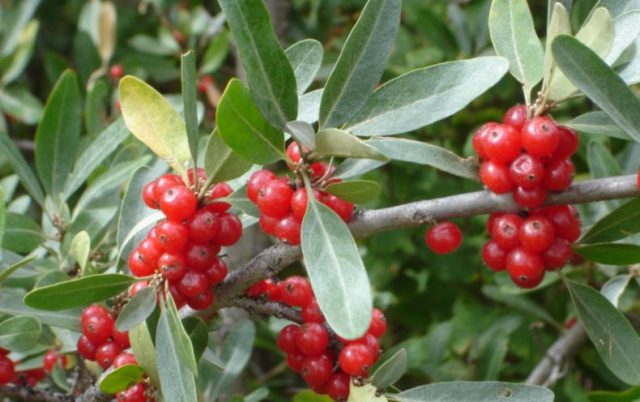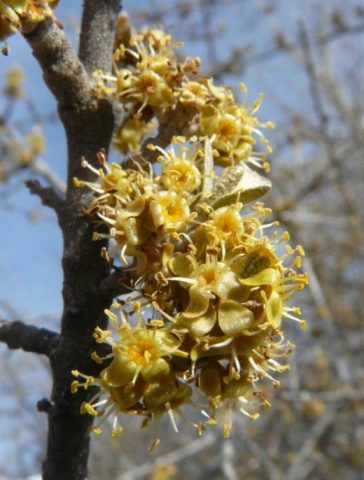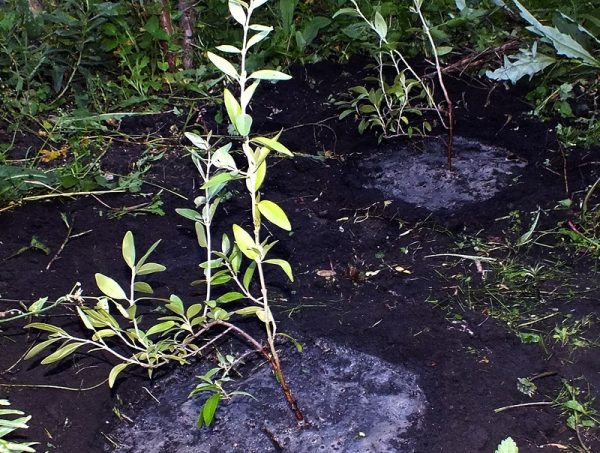Content
Shepherdia Silver looks like sea buckthorn. But this is a completely different plant. It is worth finding out how these plants differ, what characterizes the American guest, the reasons for its appearance in Russian gardens.
Description of berry culture
A plant of the Lokhov family, which includes sea buckthorn. It is also known as red sea buckthorn... It is a tall shrub, prickly, sometimes not. The plant is dioecious. Female specimens require a male pollinator.
General idea of the plant
The bushes grow up to a height of 4 meters. The branches are thin, crooked, often prickly. The leaves are oblong, covered with a silvery downy. Small yellow flowers appear before the leaves open in April.
Distinguish between male and female plants by the type of flower buds. Female bushes cover small pointed buds; in the male species, they are large and rounded. The plant is very decorative at any time of spring and summer. The silvery bush is decorated with yellow flowers in spring and red berries in summer.
Berries
Berries appear in the second year after planting. The berries are round, up to one and a half centimeters in diameter. Bright red, with small specks, edible for humans and birds. The taste is sour with bitterness, tart. Ripen by early September. The tasting score is low, it is simply impossible to eat them.
Red sea buckthorn Shepherdia is shown in the photo.
Characteristic
Shepherdia Silver is a deciduous plant. Its growth area is wide enough. This is due to its winter hardiness. Other American varieties of these berries are less popular in Russia. Shepherdia Canadian bears fruit with unsuitable berries for food, and Round-leaved has low frost resistance.
Main advantages
Shepherdia Silver has taken root well in the European climate. This is a frost-resistant plant, drought is not terrible for him. It is not affected by diseases and pests. Unpretentious, requires a minimum of maintenance. Quietly neighbors with various plants.
Flowering period and ripening time
Shepherdia Silvery blooms in April before the leaves appear. The clusters of small flowers stay on the branches for no more than 10 days. The berries reach maturity by the end of August. If left on the bush until frost, they will become sweeter.
Yield indicators, fruiting dates
With proper care, the plant will yield bountiful crops. A young bush 2 years after planting will give 15 kg of berries. Fruiting every year up to 30-50 years. The yield increases every year and can reach 30 kg per tree.
Scope of berries
In fresh form, it is almost never used because of the astringent tart aftertaste. Cooked desserts, sweet preparations in the form of jam or compote, low-alcohol drinks are popular. Shepherdia's benefits are invaluable. It is added to sauces for meat and fish dishes.
The benefits and harms of Shepherdia
Shepherdia berries contain more vitamin C than sea buckthorn, black currant, lemon. The contained carotene, tannins, vitamins A, E, P have a positive effect on the human body. The beneficial properties of Shepherdia Silver for humans are as follows:
- Improves tone.
- Strengthens the immune system.
- Slows down the aging of the body.
- Prevents and treats viral infections and inflammations.
- Strengthens blood vessels, prevents hypertension, atherosclerosis.
- Has a choleretic and diuretic effect.
It can harm people with an allergic reaction to berries.
Disease and pest resistance
Shepherdia is highly resistant to various fungal and viral plant diseases. Pests do not annoy her either. This characteristic of Shepherdia allows you to exclude the treatment of shrubs with insecticides and get an environmentally friendly harvest.
Advantages and disadvantages of the variety
Shepherdia has the following advantages:
- Unpretentiousness.
- Frost resistance.
- Easy reproduction.
- Immunity to diseases and pests.
- Useful medicinal qualities.
- Good transportability.
The disadvantages include the self-infertility of the plant, the mandatory selection of a male plant for pollination.
Landing rules
Shepherdia tree does not require special growing conditions. Its branched root system allows it to grow in rocky and steep areas.
Recommended timing
The best time to plant is spring. This is especially true in the Urals and Siberia. In the spring, Shepherdia is planted in April, when the soil thaws, but the buds have not yet woken up.
Choosing the right place
Shepherdia bushes are planted in full sun. She needs space. Low swampy places where fog and stagnant groundwater are possible are not suitable.
Soil preparation
Sandy and loamy soils will be good. They are quite nutritious and loose. Shepherdia herself can improve the soil on which it grows. The bacteria balls located on the roots provide the soil with nitrogen.
Selection and preparation of seedlings
For planting, seedlings with a developed root system are used. Cut dry and diseased roots. Healthy ones are pruned by 3 cm without touching the nodules. The branches are shortened by 1/3. The seedlings are placed in a solution of "Epin", "Heteroauxin" or potassium permanganate.
Algorithm and scheme of landing
Planting and caring for Shepherdia is nothing special. The first step is to prepare a landing pit 50 x 50 x 50 cm. A hill of fertile soil is poured into the middle. A seedling is placed on it, the roots are straightened.
Sprinkle the seedling with earth, while it is easily shaken to compact the soil. Planting is watered and mulched. 1.5-2 m are left between the seedlings. If you plan to make a hedge, half a meter is enough.
Follow-up care of the culture
Any plant needs care. And for the shepherdia, a number of activities should be carried out in order to get the sea buckthorn harvest.
Necessary activities
Shepherdia gratefully responds to fertilization. In the spring, rotted manure containing nitrogen, urea or ammonium sulfate is introduced. In the middle and at the end of summer, add superphosphate, potassium sulfate, ash infusion.
During the formation of berries, the bush is watered, especially in dry summers. Young trees loosen and mulch. This protects the superficial root system. An adult plant does not require this.
Shrub pruning
Shepherdia grows rapidly and branches intensively. Pruning is essential for this plant. It should be formed. The central shoot is cut at a height of 2.5 m, the lateral ones - at the first branch. This is done every 3-5 years, preventing the tree from growing and facilitating the conditions for picking berries.
Anti-aging pruning is performed every 7 years. Branches older than 7 years are pruned, giving room for the growth of young shoots. And another important point is sanitary pruning, removal of diseased and broken branches. It is held every spring.
Preparing for winter
The winter hardiness zone of Shepherdia Silver is quite wide.These are all regions of Russia, except for the Far North. She tolerates frosts down to -40 0C. No winter shelter is required for the bush. Only young seedlings are insulated and mulched.
How Shepherdia reproduces
The main ways of breeding Shepherdia:
- Seeds.
- Root offspring.
- Cuttings.
Seed propagation
Shepherdia Seeds can be obtained by yourself. To do this, the berries are ground into porridge and dried in the sun, then the grains are separated. They are planted in the year of harvest, as they quickly lose their ability to germinate.
Seeds are planted in an unheated greenhouse in November. Planting depth - 2-3 cm. Seedlings appear at the end of April. By autumn, the seedlings reach a height of 15 cm, they are transplanted to the chosen place. Shepherdia from seeds retains all the varietal characteristics of the plant. Begins to bear fruit in 5 years.
Reproduction by root shoots
Shoots formed at a distance of 1.5-2 m from the tree are used. Choose 2 year old plants. Having dug up the soil, cut off the shoot from the main bush, dig it up. The cut sites are disinfected. The bushes are planted immediately in a permanent place. They are watered and protected from the heat.
Propagation by cuttings
The top of the green shoot or its middle part is used as a cutting. It is necessary to choose not yet lignified shoots. Cuttings are prepared in early July. Further actions are fully consistent with the principles of propagation by cuttings of berry bushes.
Shepherdia in landscape design
This shrub is often used to decorate the garden and landscape in urban and home gardens. Shepherdia is suitable for arranging a hedge, strengthening the slopes.
In single plantings, the tree becomes a prominent accent, covered in silvery foliage and red berries. The varieties of Shepherdia Silver for the Moscow region include the decorative type of Golden. The tree is strewn with bright yellow berries.
Photos of Shepherdia Silver can be seen below.
Diseases and pests, methods of control and prevention
No matter how hard they tried to find the diseases that afflict Shepherdia, it should still be admitted that they are absent. The same can be said for pests.
Conclusion
Shepherdia Silver was noticed by Michurin. Currently, it is not very popular with Russian gardeners. Sea buckthorn is better known. But Shepherdia deserves to be used to get healthy berries and decorate the garden.












